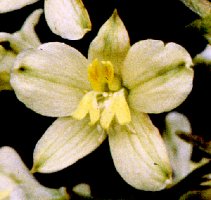 The yellow delphinium, D. zalil,
originates from the hot climate of Iran and has wide open
florets. The colour is greatly enhanced by the bright
yellow petals forming the eye.
The yellow delphinium, D. zalil,
originates from the hot climate of Iran and has wide open
florets. The colour is greatly enhanced by the bright
yellow petals forming the eye. As in a typical delphinium floret, there are two types of petal. The pair of petals at the top have a relatively small coloured bract but have a tubular spur projecting backwards. The dark marking of these upper spur petals are associated with rows of coloured hairs forming 'beards'.
The bracts of the lower pair of petals, or 'honey leaves', are much larger and are clearly bifid, with a sharp incision at the end of each petal. Beards formed by yellow hairs extend down these petals and enhance their colour.
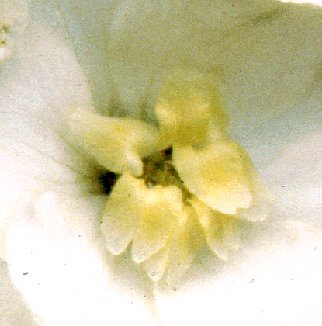 The colour of creamy yellow garden delphiniums
is often enhanced by the stronger colour of the eye, just
as for D. zalil. In this example, much of the
strongest yellow colouring is due to yellow hairs forming
the petal beards.
The colour of creamy yellow garden delphiniums
is often enhanced by the stronger colour of the eye, just
as for D. zalil. In this example, much of the
strongest yellow colouring is due to yellow hairs forming
the petal beards. Notice that although this semi-double hybrid flower has more petals than a species delphinium, the bifid character of petals is clearly retained.
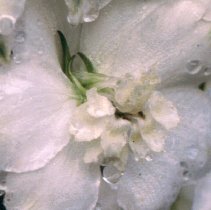 Petal spurs are
hidden in the spur on the top sepal of the first two
flowers shown here. That is not true for all cultivated
delphiniums and spurs are sometimes seen in the face of
the flower. If there is only one spur, this does not
spoil the appearance too much. There are even some
selected 'named' delphiniums with the petal spur exposed.
Petal spurs are
hidden in the spur on the top sepal of the first two
flowers shown here. That is not true for all cultivated
delphiniums and spurs are sometimes seen in the face of
the flower. If there is only one spur, this does not
spoil the appearance too much. There are even some
selected 'named' delphiniums with the petal spur exposed.When several spurs can be seen, as for this seedling, they spoil the appearance. This would be a good reason for a breeder to reject the plant.
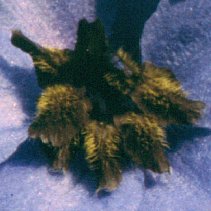
Petal beards often make the eye of a garden delphinium more interesting. For this blue flower the yellow hairs on brown petals give the impression that a bee or big spider is lurking in the centre of the flower.
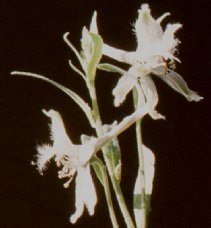
Plant breeders have not really paid much attention to raising delphiniums with prominent beards. The potential scope for this is shown by the flowers of the prairie larkspur D. carolinianum s.s.p. virescens.
The petal beards of this white flower are very prominent and encourage one to imagine that it would be possible to have a delphinium with a very feathery cluster as the eye.
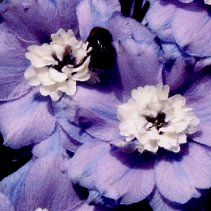
Delphinium breeders tend to look for flowers having many petals in the eye and with a contrast in colour to the sepals.
This seedling has many petals in a neat cluster but the centre is open exposing the anthers and stigmas to view. This is a characteristic inherited from its parent, the well known English delphinium 'Spindrift'.
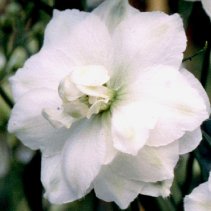
It can be attractive to have the petals curving inwards to form a neat bobble eye with the anthers and stigmas hidden. Such clusters normally tend to open out as the flower ages.